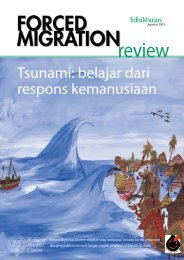FMR 42 full issue pdf - Forced Migration Review
FMR 42 full issue pdf - Forced Migration Review
FMR 42 full issue pdf - Forced Migration Review
You also want an ePaper? Increase the reach of your titles
YUMPU automatically turns print PDFs into web optimized ePapers that Google loves.
<strong>FMR</strong> <strong>42</strong><br />
Sexual orientation and gender identity and the protection of forced migrants 53<br />
fellow countrymen in accessing the asylum<br />
process and securing employment and<br />
accommodation; after some time they reduced<br />
these contacts and started searching for spaces<br />
where they could be open about their sexual<br />
orientation and/or gender identity. However,<br />
due to the general homophobic climate in<br />
Nairobi and the threat of extortion and<br />
violence upon exposure, many of the sexual<br />
minority refugees found refuge with Kenyan,<br />
foreign and other refugee men, securing<br />
accommodation and food in exchange for sex.<br />
Some of these relations were characterised<br />
by dependency due to extortion; at least two<br />
cases amounted to sexual enslavement.<br />
Fear of exposure by neighbours and landlords<br />
in Nairobi forces sexual minority refugees<br />
to move frequently from one lodging to<br />
another. Isolation and constant stress due to<br />
lack of protection and the impossibility of<br />
local integration may explain the high rates<br />
of PTSD among participants in Kenya. At<br />
69% this rate is similar to rates in Israel.<br />
Conclusions<br />
In Nairobi, in recognition of generalised<br />
homophobia and threats towards LGBTI<br />
individuals, both HIAS Refugee Trust of<br />
Kenya and the Refugee Consortium of Kenya<br />
are operating specific programmes addressing<br />
the legal, psychosocial and shelter needs of<br />
sexual minority refugees. In Israel, where<br />
there is a general perception of tolerance<br />
towards sexual minorities, there are only<br />
minimal proactive measures being taken by<br />
assistance providers to enhance protection<br />
of this particular vulnerable group. Both<br />
settings demand further development of<br />
specific outreach and identification strategies<br />
and proactive protection measures.<br />
LGBTI and refugee assistance agencies should:<br />
■■train local LGBTI advocates on the<br />
legitimacy of SOGI-based persecution<br />
in claiming international protection and<br />
incorporate them into a wider referral<br />
network<br />
■■post information about SOGI-based<br />
persecution and international protection on<br />
relevant websites<br />
■■extend outreach, identification and referral<br />
systems specifically to urban centres beyond<br />
Nairobi and Tel Aviv<br />
■■facilitate social support groups for sexual<br />
minority refugees including integration into<br />
social activities and vocational training run<br />
by LGBTI civil society<br />
■■improve access to psychosocial assistance<br />
by extending training on SOGI to<br />
professionals in Kenya<br />
■■provide safe shelters for sexual minority<br />
refugees in Kenya to reduce the need to<br />
form dependent relations with abusive<br />
hosts.<br />
Yiftach Millo yiftach.hias@gmail.com is a<br />
research consultant for Hebrew Immigrant Aid<br />
Society www.hias.org Full research results<br />
online: HIAS Invisible in the City: Protection<br />
Gaps Facing Sexual Minority Refugees in Urban<br />
Ecuador, Ghana, Israel and Kenya<br />
http://tinyurl.com/HIAS-invisible-in-city<br />
1. The sample size is too small to represent the targeted population<br />
but may be indicative of a possible trend that needs to be further<br />
researched.




